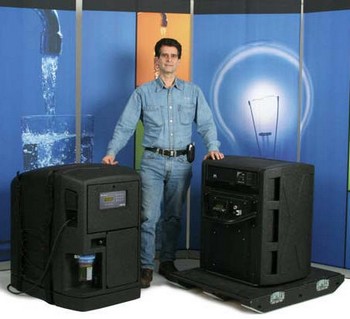from http://starbulletin.com/2008/03/03/news/story01.html
COURTESY SHIGEO YAMADA
Japanese sailor Ken-ichi Horie waves from the deck of the Suntory Mermaid II, which sails by converting wave energy into forward thrust. Horie plans to depart from Hawaii on March 16 for Japan, the first time the trip will be attempted by a wave-powered vessel. |
Waverider
An adventurer hopes the power of waves sails him to Japan
STORY SUMMARY » It is counterintuitive that a boat that relies on wave propulsion could move in the direction of oncoming waves.
But that is just what the Suntory Mermaid II does.
Now, Japanese adventurer Ken-ichi Horie is planning to skipper the world's foremost wave-powered vessel 4,350 miles from Hawaii to Japan.
In the process, Horie aims to add a new world record to his collection. In 1992 he set the Guinness record for the greatest distance by pedal-boat after pedaling 4,660 miles from Hawaii to Okinawa. In 1996 he set another record for the first solar-powered crossing of the Pacific. And he sailed 9,943 miles from Ecuador to Japan in a boat made from recycled beer cans.
COURTESY SHIGEO YAMADA
The propulsion system of the Suntory Mermaid II is visible with the boat partially lifted out of the water. |
|
Horie, 69, arrived in Honolulu over the weekend to begin preparations for his latest eco-adventure aboard the Mermaid II, a 3-ton yacht propelled by wave energy. Its two parallel fins translate the vertical motion of the waves into an effect resembling the lobes of a dolphin's tail, providing a backward "kick."
The trip should take 14 weeks.
FULL STORY »
COURTESY SHIGEO YAMADA The Suntory Mermaid II, which is powered by wave energy, will sail from Hawaii to Japan under the control of Japanese sailor Ken-ichi Horie. Horie will depart March 16 from the Hawaii Yacht Club in Waikiki and expects to take about three months to compete the voyage. |
|
Star-Bulletin staff
Japanese sailor Ken-ichi Horie is planning to captain the world's foremost wave-powered vessel 4,350 miles from Hawaii to Japan and in the process set a new world record.
Horie, 69, arrived in Honolulu over the weekend to begin preparations for his latest eco-adventure aboard the Suntory Mermaid II, a 3-ton yacht propelled by wave energy.
Yutaka Terao, a mechanical engineering professor at Tokai University, designed the wave technology.
"One day, fossil fuel will run out," Terao said in a news release.
Terao has researched wave technology for decades and sees wave propulsion as a promising system to save energy.
The technology works by way of two fins, side by side, at the bow of the Suntory that absorb the vertical energy of waves and produce a "dolphin kick" to propel the boat forward and against waves.
As an added benefit, the fins absorb the wave motion and stabilize the boat.
Horie is making his trip as green as possible.
The Suntory, a 30-foot catamaran, is equipped with solar panels to power Horie's equipment and cell phone. The hull is made of recycled aluminum.
While the Suntory has a 35-foot mast and an engine on the stern, the equipment is intended for emergency use only.
COURTESY SHIGEO YAMADA
Ken-ichi Horie |
|
Horie's voyage is the latest in a string of eco-adventures that started in 1962 when he sailed solo across the Pacific. In 1992 he set the Guinness record for the greatest distance by pedal-boat after pedaling 4,660 miles from Hawaii to Okinawa.
In 1996 he set another Guinness record for the first solar-powered crossing of the Pacific. He sailed 9,943 miles from Ecuador to Japan in an aluminum boat made from recycled beer cans. If his next trip is a success, he will have a world record for the greatest distance traveled in a wave-powered boat.
On March 16, Horie will depart from the Hawaii Yacht Club in Waikiki. With the Suntory traveling at a top speed of 5 knots, it will take about three months for Horie to reach Japan, something a diesel-powered boat can do in about 10 days.
But speed is not the point. Horie hopes the voyage will prove that the technology really works.
"Innovation is very important," said his spokesman, Ken Dota. He said Horie hopes the shipping industry will take notice, improve the technology and eventually adopt it.
Suntory Mermaid II

COURTESY KEVIN HAND / POPULAR SCIENCE
It is counterintuitive that a boat that relies on wave propulsion could move in the direction of oncoming waves, but that is just what the Suntory Mermaid II does. Its two parallel fins translate the vertical motion of the waves into an effect resembling the lobes of a dolphin's tail, providing a backward "kick." In the process, the fins gather energy from the clumsy pitch and roll of the hull, increasing stability. The twin hulls help channel the energy into forward motion.
It is not a new concept. In fact, the first description of a wave-power boat dates to 1895, when an English patent application described a craft that could move at 4 knots (5 mph). The Suntory Mermaid II tops that speed by 1 knot.















